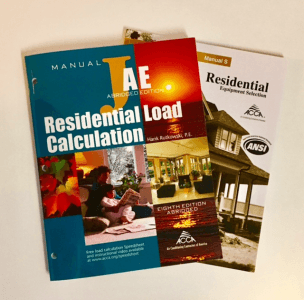
Installing a new air conditioner or heating unit in your home is an intricate process because every house is unique and requires a specific amount of heating and cooling to keep your home warm in the winters and cool in the summers. In order to provide consistent comfort for you and your family, it is necessary to have appropriately sized equipment.
When purchasing a new system, completing a Manual J Load Calculation before installation is the only precise method a homeowner can trust to accurately measure their heating and cooling load. If you are replacing an existing system, technicians will often refer to the data plate of the original unit for measurements. Many contractors who follow this method rely on a general rule of thumb (400 sq.ft. per ton) for their calculations. However, this shortcut is not ideal because buildings change over time in various ways that may significantly affect the size of the load.

HVAC systems impact a home’s air quality, energy efficiency and overall comfort. An oversized unit will lead to short-cycling and other risks that will drastically affect these three qualities of your home.
Short-cycling is when your HVAC system constantly turns on and shuts off (every few minutes). Bigger is not always better, your oversized system is causing this to happen because it is so powerful, it cools your house down quickly enough to satisfy the thermostat but you are left with an uncomfortable level of humidity.
Most AC units need to run for at least ten minutes before they begin dehumidifying the air. If your system is frequently turning on and off, it doesn’t allow enough time for humidity to condense. This results in extra unnecessary wear and tear to your equipment from frequent starting and leaves your home feeling humid and stuffy.
On the other hand, if you’re system is too small, it will run continuously, struggling to fulfill your home’s heat load. This may never allow your home to reach your desired temperature setting. An undersized unit will increase your energy usage and raise costs from constantly working so hard.
Incorrect sizing is one of the most critical aspects with any comfort system and the only way to avoid this issue is to put in the extra effort from the start and complete a Manual J Load Calculation before installation. Not after the installation is finished for the sole purpose of utility rebate incentives. Before the installation is started for the sole purpose that the equipment is sized right.
Performing a load calculation can be rather complex as there are several factors to obtain that will determine the load calculation for a particular house. Load calculations are not based on square footage; they’re based on construction materials and occupant usage. To give you a better understanding of what exactly goes into a load calculation, see the list below:
Factors to consider when completing a Manual J Load Calculation:
- What material is the house made of? Wood frame or Block?
- Measurements of the home’s exterior and often each room?
- What type of windows are there? How many panes and what type of frame?
- Are there window coverings? (Blinds, curtains, outside umbrellas, etc.)
- How many exterior doors are there and what are they made of?
- What type of roof? Tile Concrete, asphalt, or membrane?
- Is there insulation in the attic? What about in the walls? What Type?
- How many occupants are living in the house?
- Vaulted ceilings?
- What is the potential for air leakage?
- Where is the duct work installed and what is the R-Value?
- How leaky are the ducts?
- What direction does the home face?
Each of the elements above are factors that go into a load calculation. The list goes on but these are a few of the key ingredients that affect the size of a load. Every load for every house will be different because every house contains different ingredients. There could be two identical-looking homes built next to each other and yet each could require a different sized system. Does one house have six people living in it while the other has only two? Does one house have proper insulation but the other lacks? A simple swap of ingredients can change the entire recipe.
Each heating and cooling equipment system is sold with measured efficiency ratings called AHRI. The equipment efficiency is measured using proper installation and specific designed conditions. The certified AHRI ratings will not be achieved if the equipment is installed in an over-sized or under-sized load environment. You may be buying a 14 SEER or 16 SEER system but if the load conditions do not match the rated capacity of the equipment those efficiency expectations will not be meet.
We understand the importance of completing a Manual J Load Calculation and we want to ensure you are getting the best service the first time around. For every single installation we make, we perform a complete and thorough load calculation to guarantee that we provide the optimal system to keep you and your family consistently comfortable!

